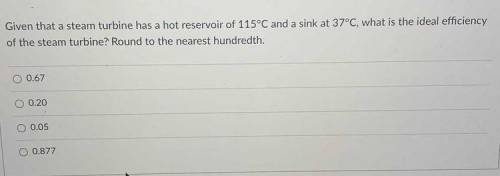Question 3
1 pts
Given that a steam turbine has a hot reservoir of 115°C and a sink at
...

Physics, 05.12.2020 05:50 mariap3504
Question 3
1 pts
Given that a steam turbine has a hot reservoir of 115°C and a sink at
37°C, what is the ideal efficiency of the steam turbine? Round to the
nearest hundredth.
O 0.877
O 0.20
O 0.05
O 0.67


Answers: 1


Another question on Physics


Physics, 22.06.2019 12:10
Consider a one meter long horizontal pipe with a constant 100 cm^2 cross sectional area. water flows rightward into the pipe at x = 0 with flow velocity 02m/sec at every point within the pipe intake area. at x=1, the rightward flow rate is 0.192 m/sec. assume the water is a conserved quantity in the pipe, so there must be a leak (a sink) somewhere in the pipe. 1. compute net volumetric flow of the source if the system to be in equilibrium. 2. now assume the pipe in the problem has no leaks. compute the net volumetric rate of change for the system.
Answers: 3

Physics, 22.06.2019 15:30
To understand the electric potential and electric field of a point charge in three dimensions consider a positive point charge q, located at the origin of three-dimensional space. throughout this problem, use k in place of 14? ? 0. part adue to symmetry, the electric field of a point charge at the origin must point from the origin.answer in one word.part bfind e(r), the magnitude of the electric field at distance r from the point charge q.express your answer in terms of r, k, and q. part cfind v(r), the electric potential at distance rfrom the point charge q.express your answer in terms of r, k, and q part dwhich of the following is the correct relationship between the magnitude of a radial electric field and its associated electric potential ? more than one answer may be correct for the particular case of a point charge at the origin, but you should choose the correct general relationship. a)e(r)=dv(r)drb)e(r)=v(r)rc)e(r)=? dv(r)drd)e(r)=? v(r)r
Answers: 2

Physics, 22.06.2019 17:00
Adiver named jacques observes a bubble of air rising from the bottom of a lake (where the absolute pressure is 3.50 atm) to the surface (where the pressure is 1.00 atm). the temperature at the bottom is 4.00 ∘c, and the temperature at the surface is 23.0 ∘c.what is the ratio of the volume of the bubble as it reaches the surface (vs) to its volume at the bottom (vb)? if jaques were to hold his breath the air in his lungs would be kept at a constant temperature. would it be safe for jacques to hold his breath while ascending from the bottom of the lake to the surface?
Answers: 1
You know the right answer?
Questions


History, 20.09.2019 20:00

Chemistry, 20.09.2019 20:00


Biology, 20.09.2019 20:00



Physics, 20.09.2019 20:00





Mathematics, 20.09.2019 20:00

Social Studies, 20.09.2019 20:00

Mathematics, 20.09.2019 20:00

Mathematics, 20.09.2019 20:00


Biology, 20.09.2019 20:00




